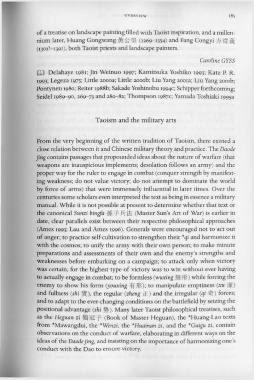Page 225 - The Encyclopedia of Taoism v1_A-L
P. 225
OVERVIEW 185
of a treatise on landscape painting filled with Taoist inspiration, and a millen-
nium later, Huang Gongwang Jt1,; m (1269-1354) and Fang Congyi l:HfH~
(13or?-1391), both Taoist priests and landscape painters.
Caroline GYSS
m Delahaye 1981; Jin Weinuo 1997; Kamitsuka Yoshiko 1993; Katz P. R.
1993; Legeza 1975; Little 2000a; Little 2000b; Liu Yang 20ora; Liu Yang 20orb;
Pontynen 1980; Reiter 1988b; Sakade Yoshinobu 1994C; Schipper forthcoming;
Seidel 1989-90, 269-73 and 280-82; Thompson 1987C; Yamada Toshiaki 1995a
Taoism and the military arts
From the very beginning of the written tradition of Taoism, there existed a
close relation between it and Chinese military theory and practice. The Daode
jing contains passages that propounded ideas about the nature of warfare (that
weapons are inauspicious implements; desolation follows an army) and the
proper way for the ruler to engage in combat (conquer strength by manifest-
ing weakness; do not value victory; do not attempt to dominate the world
by force of arms) that were immensely influential in later times. Over the
centuries some scholars even interpreted the text as being in essence a military
manual. While it is not possible at present to determine whether that text or
the canonical Sunzi bingfa ~ T~~ (Master Sun's Art of War) is earlier in
date, clear parallels exist between their respective philosophical approaches
(Arnes 1993; Lau and Arnes 1996). Generals were encouraged not to act out
of anger; to practice self-cultivation to strengthen their *qi and harmonize it
with the cosmos; to unifY the army with their own person; to make minute
preparations and assessments of their own and the enemy's strengths and
weaknesses before embarking on a campaign; to attack only when victory
was certain, for the highest type of victory was to win without ever having
to actually engage in combat; to be formless (wuxing ~%) while forcing the
enemy to show his form (youxing :ff%); to manipulate emptiness (xu J1ii.)
and fullness (shi ~), the regular (zheng lE) and the irregular (qi iD-) forces;
and to adapt to the ever-changing conditions on the battlefield by seizing the
positional advantage (shi ~). Many later Taoist philosophical treatises, such
as the Heguan zi 1t~Ja;T (Book of Master Heguan), the *Huang-Lao texts
from *Mawangdui, the *Wenzi, the *Huainan zi, and the *Guigu zi, contain
observations on the conduct of warfare, elaborating in different ways on the
ideas of the Daode jing, and insisting on the importance of harmonizing one's
conduct with the Dao to ensure victory

